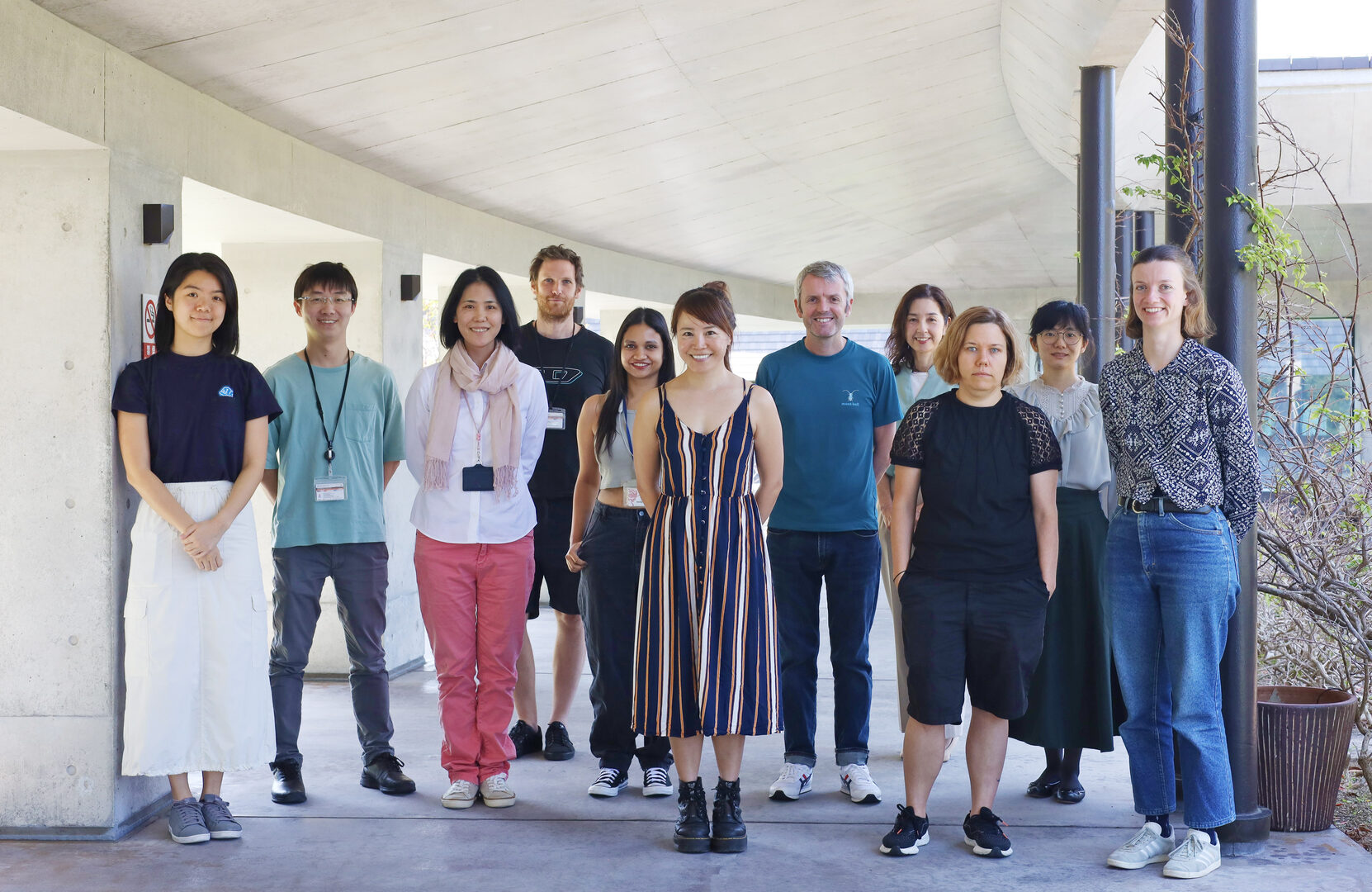FY2023 Annual Report
Sensory and Behavioural Neuroscience Unit
Associate Professor Izumi Fukunaga
From left: Shin-Yu Lee (collaborator, Pääbo Unit), Xiangchun Ju (collaborator, Pääbo Unit), Izumi Fukunaga, Adam Mago, Sourjya Bhaibabee Nath, Yu-Pei Huang, Patrick Stoney, Sayori Gordon, Janine K Reinert, Xiaochen Fu, Josefine Reuschenbach.
Abstract
The Sensory and Behavioural Neuroscience Unit seeks to understand how the brain processes incoming sensory information from the environment.
Two broad directions include:
(1) Investigations into the circuit mechanisms that extracts and conditions signals evoked by odours; what features of chemical information neurons in the primary olfactory represent, and with what neural codes they do so and what circuit mechanisms underlie generation of such codes? For example, Xiaochen Fu (PhD student) leads a project where the olfactory bulb output neurons are optogenetically stimulated using temporally precise light pulses, in sync with animal behaviour. By combining this with a behavioural paradigm, we can test what temporal patterns are perceptible and distinguishable for mice.
(2) How this sensory (olfactory) processing is tuned by behavioural contexts flexibly; we investigate the interactions between local iteractions and long-range inputs that are thought to carry internally generated signals. In a project led by Sander Lindeman, we described that the olfactory bulb output neurons are modulated by reward expectation in a cell-type specific manner. This result is now published (Lindeman et al., 2024, PloS BIOLOGY).
1. Staff
- Dr. Izumi Fukunaga, Principal Investigator
- Dr. Sander Lindeman, Post-doctoral Researcher (until December 2023)
- Dr. Janine Reinert, Post-doctoral Researcher
- Dr. Adam Mago, Post-doctoral Researcher
- Dr. Patrick Stoney, Post-doctoral Researcher (from 2024)
- Ms. Xiaochen Fu, Graduate Student
- Ms. Josefine Reuschenbach, Graduate Student
- Ms. Sourjya Baibhabee Nath, Graduate Student
- Ms. Yu-Pei Huang, Technical Staff
- Ms. Sayori Gordon, Administrative Assistant
2. Collaborations
- Prof Hiroto Sekiguchi (Toyohashi University of Technology, Japan)
- Prof. Svante Pääbo, Dr. Xiangchun Ju, and Dr. Shin-Yu Lee (Human Evolutionary Genomics Unit, OIST)
- Prof. Vincent Laudet (Marine Eco-Evo-Devo Unit, OIST)
- Prof. Cindy Poo (Allen Institute for Neural Dynamics, USA)
- Prof. Federico Calegari (University of Dresden, Germany)
3. Activities and Findings
3.1 Value-related learning in the olfactory bulb occurs through pathway-dependent perisomatic inhibition of mitral cells
Associating values to environmental cues is a critical aspect of learning from experiences, allowing animals to predict and maximise future rewards. Value-related signals in the brain were once considered a property of higher sensory regions, but their wide distribution across many brain regions is increasingly recognised. Here, we investigate how reward-related signals begin to be incorporated, mechanistically, at the earliest stage of olfactory processing, namely, in the olfactory bulb. In head-fixed mice performing Go/No-Go discrimination of closely related olfactory mixtures, rewarded odours evoke widespread inhibition in one class of output neurons, that is, in mitral cells but not tufted cells. The temporal characteristics of this reward-related inhibition suggest it is odour-driven, but it is also context-dependent since it is absent during pseudo-conditioning and pharmacological silencing of the piriform cortex. Further, the reward-related modulation is present in the somata but not in the apical dendritic tuft of mitral cells, suggesting an involvement of circuit components located deep in the olfactory bulb. Depth-resolved imaging from granule cell dendritic gemmules suggests that granule cells that target mitral cells receive a reward-related extrinsic drive. Thus, our study supports the notion that value-related modulation of olfactory signals is a characteristic of olfactory processing in the primary olfactory area and narrows down the possible underlying mechanisms to deeper circuit components that contact mitral cells perisomatically.
3.2 Probing stimulus encoding in the olfactory bulb using synthetic olfactory stimuli
An essential task for the sensory systems of the brain is to encode external stimuli as patterns of neuronal activity. In the mouse, complex synaptic processing of odor information starts in the olfactory bulb. The output of this region is carried by at least two classes of neurons, mitral and tufted cells (M/TCs). These neurons are thought to differentially encode odors, the former using spike timing and the latter using rate coding. We are characterising the temporal patterns of M/TC activations that are perceptible and distinguishable for the animals, to probe the stimulus encoding patterns that these neurons use.
4. Publications
4.1 Journals
1. Kitade, T., Kanda, R., Matsui, K., Nishikawa, A., Loesing, A., Fukunaga, I., and Sekiguchi, H. (2024). Optimization of Gate Structure for Damageless MicroLED Thin Films in Optogenetic Applications. physica status solidi (a) n/a, 2300834. https://doi.org/10.1002/pssa.202300834.
2. Lindeman, S., Fu, X., Reinert, J.K., and Fukunaga, I. (2024). Value-related learning in the olfactory bulb occurs through pathway-dependent perisomatic inhibition of mitral cells. PLOS Biology 22, e3002536. 10.1371/journal.pbio.3002536.
3. Peace, S.T., Johnson, B.C., Werth, J.C., Li, G., Kaiser, M.E., Fukunaga, I., Schaefer, A.T., Molnar, A.C., and Cleland, T.A. (2024). Coherent olfactory bulb gamma oscillations arise from coupling independent columnar oscillators. Journal of Neurophysiology 131, 492-508. 10.1152/jn.00361.2023.
4. Reuschenbach, J., Reinert, J.K., Fu, X., and Fukunaga, I. (2023). Effects of Stimulus Timing on the Acquisition of an Olfactory Working Memory Task in Head-Fixed Mice. The Journal of Neuroscience 43, 3120. 10.1523/JNEUROSCI.1636-22.2023.
4.2 Books and other one-time publications
Book chapter
1. Fu, X., Huang, Y.-P., Lindeman, S., Mago, A., and Fukunaga, I. (2023). Dense and Sparse Labelling of Mitral Cells by Oral and Intraperitoneal Routes of Tamoxifen Administration. In The Olfactory System, B.J. Goldstein, and H. Matsunami, eds. (Springer US), pp. 185-193. 10.1007/978-1-0716-3425-7_14.
5. Intellectual Property Rights and Other Specific Achievements
Nothing to report




